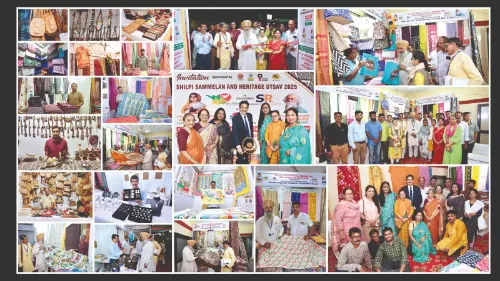Craft, Culture, and Community at Shilpi Sammelan & Heritage Utsav

NEW DELHI: At Aparajita Mahila Samiti in CR Park, the Shilpi Sammelan and Heritage Utsav 2025 is more than just an exhibition — it is a meeting ground between India’s heritage and its future. The much-anticipated event was held from September 1 to 6, 2025, bringing together master weavers, artisans, and craftspersons from across the country.
Organisers say their vision goes beyond selling products: they want to give artisans sustainable livelihoods and connect urban buyers with traditional makers whose skills often remain unseen. “There is no middleman, no commission - you are paying the weavers directly. This is a living example of Vocal for Local,” said Mrs Purnima Bhattacharyya, the organiser of the event, who also heads Women Moksha, an organisation set up in 2008. “This exhibition celebrates India’s diverse artisan heritage; it is a wonderful platform for them to showcase their skills and gain fair recognition”.
Highlights this year include Sitalpati bags by Sachin Aich, Bhagalpur sarees by Shakil, handloom women’s sarees by Susanta Debnath, and handmade jewellery by Arabinda Roy. The Utsav also proudly features National Awardee Heeraman Urweti, a renowned Gond painter from Madhya Pradesh.
Walking through the stalls, visitors are met with stories as much as with crafts. Every product carries a personal history, shaped by years of practice and inherited skills.
Sohail, hailing from Uttar Pradesh, is selling bedsheets, comforters, and other home textiles. They feature original block-printed designs on pure cotton handloom cloth dyed with natural colors, standing out in today’s market where many fabrics are mixed or machine-made.
Mohammed Ansar from Andhra Pradesh showcases Kalamkari work created using recycled fabric and painted with natural dyes. His craft has found popularity in Delhi, especially through trade fairs, where the intricate designs and sustainable approach draw a loyal audience.
Ganesh Khatri from Rajasthan brings Ajrak prints made with vegetable dyes, offering bedsheets, saris, and dress materials, with a special focus on patchwork. He admits the market has shifted toward cheap, use-and-throw fabrics, but remains confident that those who truly value craftsmanship will continue to buy from artisans like him.
Sanjay Paul, hailing from West Bengal, works with pure mud from Bengal’s rivers to create a variety of traditional terracotta items. Coming from a family long involved in the craft, the Paul family makes statues, murtis, jewellery, cups, and plates—pieces often seen in Dilli Haat and Janpath. People especially love their unique jewellery, and sales are consistently good. As true artisans, they can even recreate statues from a picture and use mud as a medium for interior decoration, blending tradition with creativity.
Bikas Das from Shantiniketan, West Bengal, specialises in kantha work on pure silk saris - a craft that takes over three months to complete each piece. His saris are exported to many countries and also sold online, and he emphasises that such work is rare to find locally. Alongside kantha, he also brings Dhakai jamdani saris made of pure cotton, keeping alive a weaving tradition that remains in demand. Confident about the future, Bikas says the profession is far from dying, and he would be proud if his children continue it. With his very reasonable pricing, he believes these saris could rise in value, as in the next decade such handcrafted treasures will become increasingly hard to find.
Together, these voices reveal that the exhibition is not only about buying a saree, a lamp, or a bag — it’s about understanding the people and traditions behind them. The organisers hope that Delhiites leave with more than shopping bags: a sense of connection to India’s living craft heritage.



